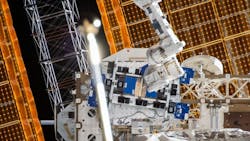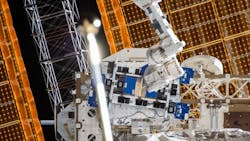First 3D-printed RF circuit launched to space
Nano Dimension, an Additively Manufactured Electronics (AME) and PE (printed electronics) provider, announced that its first ever integrated RF circuit has been flown to the International Space Station (ISS). The RF circuit was fabricated by Nano Dimension and designed and integrated by L3Harris. This project, two years in the making, was selected by the ISS U.S. National Laboratory for space effects studies.
(Source: Nano Dimension)
The project will provide a systematic analysis of an additively manufactured single board for radio frequency (RF) space systems, especially for nanosatellites, and will communicate with a ground-based satellite tracking system at Embry Riddle Aeronautical University, Daytona Beach, Florida. The primary purpose of the project is to demonstrate the viability of using new technologies, such as multi-level/multi-material AMEs, which use 3D inkjet printer-based technologies to produce monolithic RF communication systems for use in space.
This project, part of the MISSE Flight Facility, is the first systematic experiment by L3Harris and Nano Dimension aiming to analyze the RF properties of additively manufactured High-Performance Electronic Devices (Hi-PEDs) in a space environment.
Nano Dimension fabricated the single RF board using its proprietary additively manufactured electronics process in the DragonFly LDM system. The board includes the antenna, the electronic traces for mounting all the functional components and the signal ground plane. The fabricated communications device was designed by L3Harris to operate at 2.4Ghz and to be integrated into the MISSE module and launch. This device will be tested at three program points: pre-flight, in-flight, and post-flight. In this first-of-its-kind space flight experiment, the hardware will fly in the low Earth orbit (LEO) environment for six months on the ISS, which will provide scientists with a better understanding of how AME technology endures in various space environments. Low Earth orbit, a region some 1,200 miles (2,000 km) above the planet, is home to the ISS, as well as a large number of communications satellites, all of which use RF communications systems.


